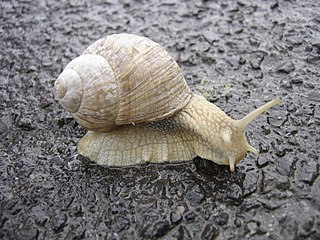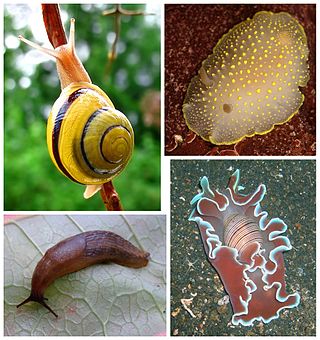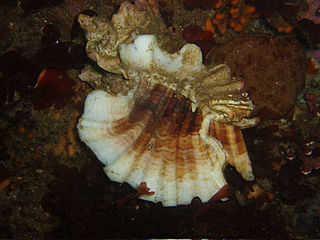
A snail is, in loose terms, a shelled gastropod. The name is most often applied to land snails, terrestrial pulmonate gastropod molluscs. However, the common name snail is also used for most of the members of the molluscan class Gastropoda that have a coiled shell that is large enough for the animal to retract completely into. When the word "snail" is used in this most general sense, it includes not just land snails but also numerous species of sea snails and freshwater snails. Gastropods that naturally lack a shell, or have only an internal shell, are mostly called slugs, and land snails that have only a very small shell are often called semi-slugs.

The gastropods, commonly known as snails and slugs, belong to a large taxonomic class of invertebrates within the phylum Mollusca called Gastropoda.

Heterobranchia, the heterobranchs, is a taxonomic clade of snails and slugs, which includes marine, aquatic and terrestrial gastropod mollusks.

Ocenebrinae is a taxonomic subfamily of predatory sea snails, marine gastropod mollusks. This subfamily is within the large family Muricidae, which are commonly known as the murex and rock snails.

The operculum is a corneous or calcareous anatomical structure like a trapdoor that exists in many groups of sea snails and freshwater snails, and also in a few groups of land snails; the structure is found in some marine and freshwater gastropods, and in a minority of terrestrial gastropods, including the families Helicinidae, Cyclophoridae, Aciculidae, Maizaniidae, Pomatiidae, etc.

Sea snail is a common name for slow-moving marine gastropod molluscs, usually with visible external shells, such as whelk or abalone. They share the taxonomic class Gastropoda with slugs, which are distinguished from snails primarily by the absence of a visible shell.

The Trochidae, common name top-snails or top-shells, are a family of various sized sea snails, marine gastropod molluscs in the subclass Vetigastropoda. This family is commonly known as the top-snails because in many species the shell resembles a toy spinning top.

Oceanida is a genus of very small parasitic sea snails, marine gastropod mollusks or micromollusks in the family Eulimidae.

Freshwater snails are gastropod mollusks which live in fresh water. There are many different families. They are found throughout the world in various habitats, ranging from ephemeral pools to the largest lakes, and from small seeps and springs to major rivers. The great majority of freshwater gastropods have a shell, with very few exceptions. Some groups of snails that live in freshwater respire using gills, whereas other groups need to reach the surface to breathe air. In addition, some are amphibious and have both gills and a lung. Most feed on algae, but many are detritivores and some are filter feeders.
Austrotrophon cerrosensis is a species of sea snail, a marine gastropod mollusk in the family Muricidae, the murex snails or rock snails.
Austrotrophon pinnata is a species of sea snail, a marine gastropod mollusk in the family Muricidae, the murex snails or rock snails.

Austrotrophon is a genus of sea snails, marine gastropod mollusks in the family Muricidae, the murex snails or rock snails.

Trophonopsis is a genus of sea snails, marine gastropod mollusks in the family Muricidae, the murex snails or rock snails.
Alaba is a genus of sea snails, marine gastropod mollusks in the family Litiopidae.

Sagartia is a genus of sea anemones in the family Sagartiidae. The genus was first described by Philip Henry Gosse in 1855 and the image is his painting of several species found in British waters included in his book, A history of the British sea-anemones and corals.
Odostomia catalinensis is a species of sea snail, a marine gastropod mollusc in the family Pyramidellidae, the pyrams and their allies.
Melanella catalinensis is a species of sea snail, a marine gastropod mollusk in the family Eulimidae. The species is one of many species known to exist within the genus, Melanella.

Conus is a genus of predatory sea snails, or cone snails, marine gastropod mollusks in the family Conidae. Prior to 2009, cone snail species had all traditionally been grouped into the single genus Conus. However, Conus is now more precisely defined, and there are several other accepted genera of cone snails. For a list of the currently accepted genera, see Conidae.

Terrestrial molluscs or land molluscs (mollusks) are an ecological group that includes all molluscs that live on land in contrast to freshwater and marine molluscs. They probably first occurred in the Carboniferous, arising from freshwater ones.
Dipsosaurus catalinensis, the Catalina desert iguana, is a species of lizard in the family Iguanidae. The species is native to Isla Santa Catalina in Mexico.














